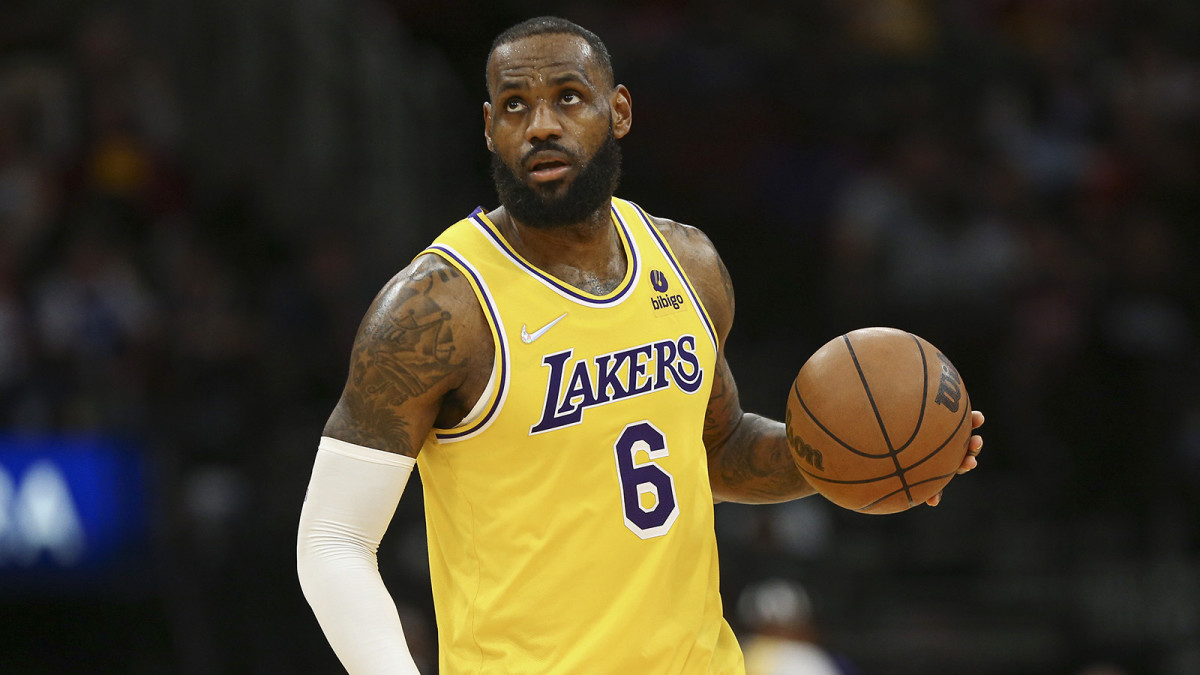LeBron at Center? Lakers Might Be On to Something

Necessity is the mother of all lineup changes. In the midst of a five-game losing streak, an injury to Anthony Davis and ineffective play from veteran bigs DeAndre Jordan and Dwight Howard, the Lakers started LeBron James at center on Tuesday night. The result? A 32-11-11 triple double for LeBron, a much-needed win for the Lakers and perhaps most importantly, a few positive signs in the shot diet of James.
A brief look at LeBron’s counting stats this season wouldn’t raise any eyebrows. Despite all of the struggles for the Lakers, James’s basic box score is very LeBronian. For the season, James is averaging 27.6 points, 7.0 rebounds, and 6.7 assists a night. His points per game would actually be his highest since his final year in Miami, though LeBron is getting a little boost in that department by playing his most minutes a night in a Los Angeles uniform. Peek a little closer at the numbers and you’ll see James is shooting 7.5 threes per game, while his free-throw attempts have dipped to a would-be career low of 5.4.
One of the more interesting long-term developments of James’s career has been his embrace of the three. Remember, this was someone who in his first Finals was basically being dared to shoot by the Spurs. (A Finals that now took place nearly a decade and a half ago, but still.) The book on James was always to concede jumpers, except now at 37-years-old, he’s much more effective at making defenses pay with his shot. But are those threes worth it if they come at the expense of James shooting at the rim?
According to NBA.com’s shot tracking data, LeBron is shooting only 40.2% of his field goal attempts within 10 feet this season. That’s the lowest frequency recorded by the data, which goes back to 2014. Through 2020, that number was almost always at, near or above 50%, a testament to James’s ability and will to get into the paint or within a CDC-discouraged distance of the rim.
James is currently shooting well enough from beyond the arc that his 58.6% effective field goal percentage is his highest mark as a Laker. (Of all players launching at least 10 shots a night, LeBron is 11th in EFG%.) But James routinely used to be in the 60s in effective shooting, including his last two years in Cleveland as well as his final year in Miami. And that’s where his playing at center, which has already been beneficial for the Lakers, could get LeBron some even easier looks moving forward.
Against the Rockets, James took 19 field goal attempts, nine of which came in the paint, or 47%. He also took nine free throws and only five threes. And it’s not hard to see why LeBron’s shot distribution can change when he plays center. The Lakers simply give him so much more room to operate without a Howard or Jordan on the court, and the lineups help make up for Russell Westbrook’s lack of spacing as well.
LeBron performs really well when asked to function as a big. According to NBA.com, James generates 1.57 points per possession when acting as the roll man in a pick-and-roll, but it’s a play he runs only 2.4% of the time on offense. (Against Houston, there were two instances in the final two minutes when James set a screen for Westbrook and then rolled to the hoop for an easy dunk.) Meanwhile, James also produces 1.09 points per possession when he posts up, a figure higher than the likes of Joel Embiid and Kevin Durant, or even his teammate Anthony Davis. But James often doesn’t have the room to operate on the block with other bigs on the floor. Against the Rockets, there were multiple instances of LeBron either catching the ball on the block with the rest of the Lakers around the perimeter, or him being able to seal his man and call for the ball literally in the middle of the paint.

Getting LeBron closer to the rim means easier baskets for him, which means easier baskets for the Lakers, who need all the extra juice they can get offensively. L.A. is currently ranked 25th in offensive efficiency, and generally speaking none of LeBron’s Lakers teams have been offensive juggernauts. As the de facto center, James can operate from the block in peace, set screens for Westbrook, more easily hunt switches when a guard screens for him, and can also act as a floor spacer himself if the likes of Russ or Talen Horton-Tucker beats their defender off the dribble. (James, by the way, is a mediocre pull-up three-point shooter but a much more deadly catch-and-shoot one.)
The Lakers as a whole are so much more aesthetically pleasing to watch when the offense isn’t cramped, and the numbers bear it out. When LeBron and Russ are on the floor, they have a 97.8 offensive rating (yuck) when paired with Jordan, a 107.1 offensive rating when paired with Howard, but a 113.9 mark when none of Jordan, Howard or Davis are on the floor—or the equivalent of this season’s second-best offense in the league.
To be fair, it wasn’t only the Lakers’ lack of space that kept James out of the paint. Since Davis joined the team, LeBron clearly ceded some of his offensive responsibility to AD. Driving to the rim night after night for 19 years is incredibly physically taxing, and those pull-up jumpers likely save James from some of the pounding that comes with barreling into traffic. But now with many teams playing LeBron-sized guys at center anyway, James can play big while worrying a little bit less about banging on the block as he did years ago when his teams would downshift. (Though I still wouldn’t expect the Lakers to go small against Embiid or Nikola Jokić.)
The Rockets game was only one win against a lowly team. And the Lakers have shifted their starting lineup several times this season, be it due to injury or matchup. Still, the LeBron-at-center lineups were already becoming a staple of the rotation before L.A. started one Tuesday night. As long as Davis is out, playing LeBron at the five can’t be only a wrinkle thrown in for a few minutes a night. With how much better the offense performs with James at that position, those lineups have become a necessity.
More NBA Coverage:
• The NBA Has Chosen Its Path Against COVID
• The Warriors' Quest to Achieve What Other Franchises Couldn't
• NBA Power Rankings: Warriors Regain Top Spot, Lakers Fall
